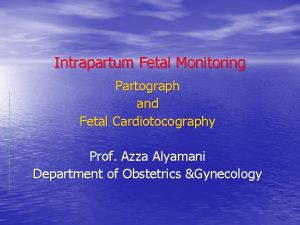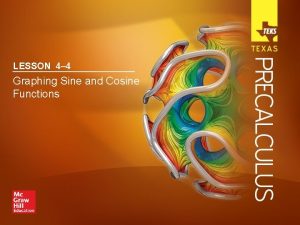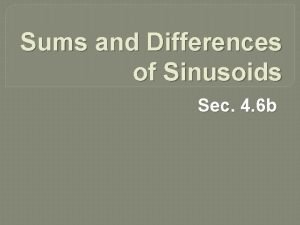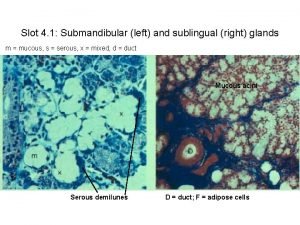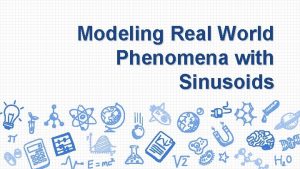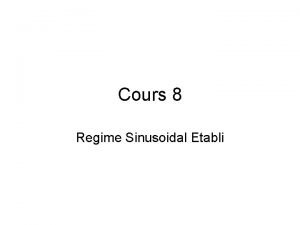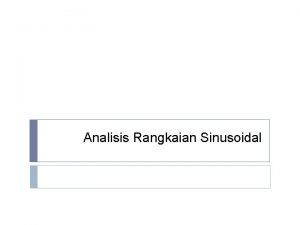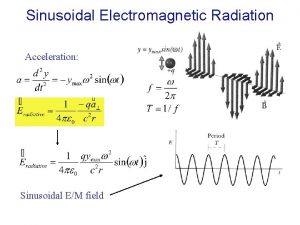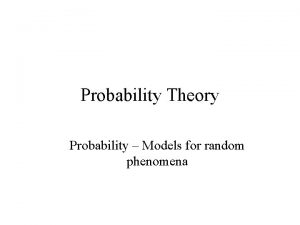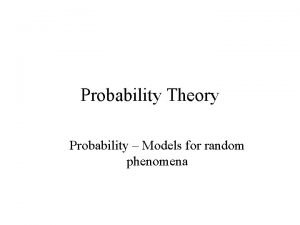Modeling Real World Phenomena with Sinusoids Sinusoidal Models









- Slides: 9

Modeling Real World Phenomena with Sinusoids

Sinusoidal Models Objective Given a verbal description of a periodic phenomenon, write an equation using sine or cosine functions (and use the equation as a mathematical model for predicting and interpreting facts about the real world).

Simple Harmonic Motion Definition Note: Simple harmonic motion equations have no place for phase or vertical shifts. This means that the graph has either a maximum, minimum, or a zero at its initial time.

Frequency and Period Frequency The number of cycles of a phenomena that occur in a certain period of time. Period The length of time between occurrences of a phenomena. Frequency and Period sound a lot alike when they are given in a problem, but they are not the same thing. In fact, they are inversely related to one another. That is to say, their formulas are reciprocals of one another. Given the equations and :

Example 1 Consider a ball that is bobbing up and down at the end of a spring. Suppose that 10 cm is the maximum distance that the ball moves vertically upward or downward from its equilibrium (at rest) position. Suppose further that the time it takes for the ball to move from its maximum displacement above zero to its maximum displacement below zero and back again is t = 4 seconds. 1. 2. 3. 4. 5. Sketch a wave that models the ball’s height as time goes on. Find the period of the ball’s height/motion. Determine the amplitude. Find the frequency (in cycles per second). Write an equation for the height of the ball. (assume that equilibrium is y = 0 cm)

Periodic/Circular/Sinusoidal Functions as Mathematical Models As we are modeling “real-world” phenomena, we will have to employ all aspects of sinusoidal equations including phase shift and vertical shift. Examples of such problems include waves, rotational, spring, and pendulum problems.

Example 2 Suppose that a waterwheel with radius 7 feet (as shown in the figure) rotates at 6 revolutions per minute (rpm). Two seconds after you start a stopwatch, bucket b on the rim of the wheel is at its greatest height, d=13 feet above the surface of the water. The center of the waterwheel is 6 feet above the surface of the water. Rotation 7 ft 6 ft 1. Sketch a wave that models the height of the bucket above/below the water). 2. Write the equation of the function that models the height of the bucket. 3. What is the height of the bucket after 1 Water Level minute and 12 seconds?

Example 3 Suppose that you are back on the beach off 30 A… Ahhh…. Now, on October 27 th at 11: 00 pm at the end of the pier, high tide was measured at 2. 4 meters. At 8: 30 am the following morning (Oct 28), the low tide was measured at 2. 0 meters. Assuming that the tide varies sinusoidally with time, 1. Sketch a wave that models the depth of the tide per time (since midnight October 28). 2. Write the equation of the model. 3. Use the model to predict the water depth at 5: 00 pm on November 1 st. 4. At what time will the (first) low tide occur on Halloween?

Assignment Worksheet Assignment 5

